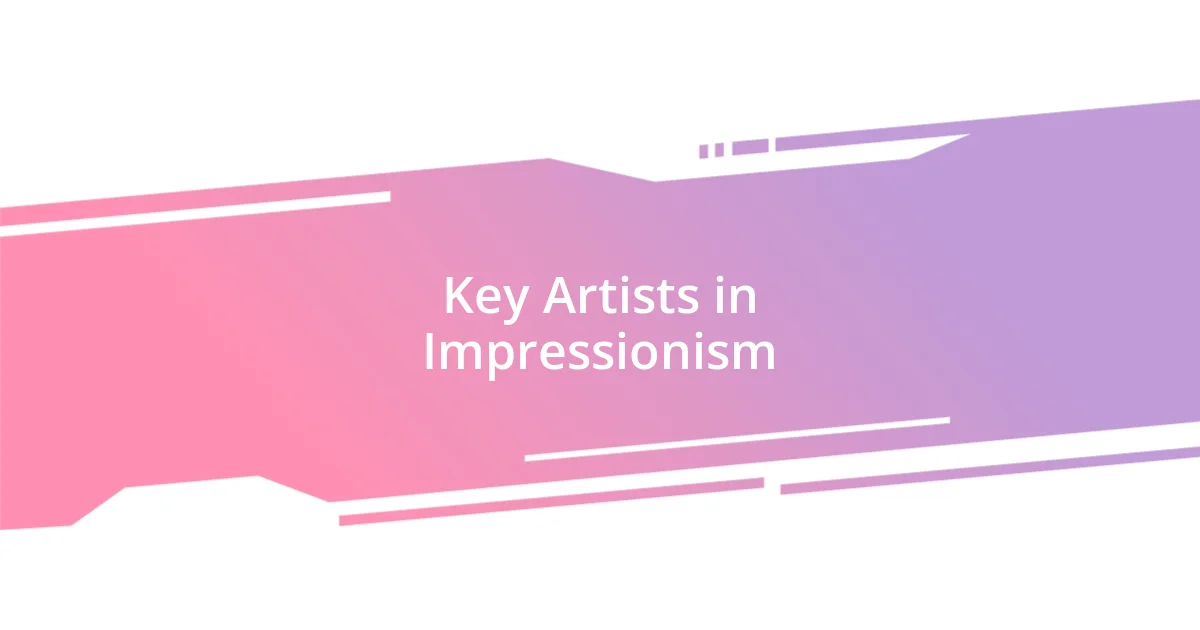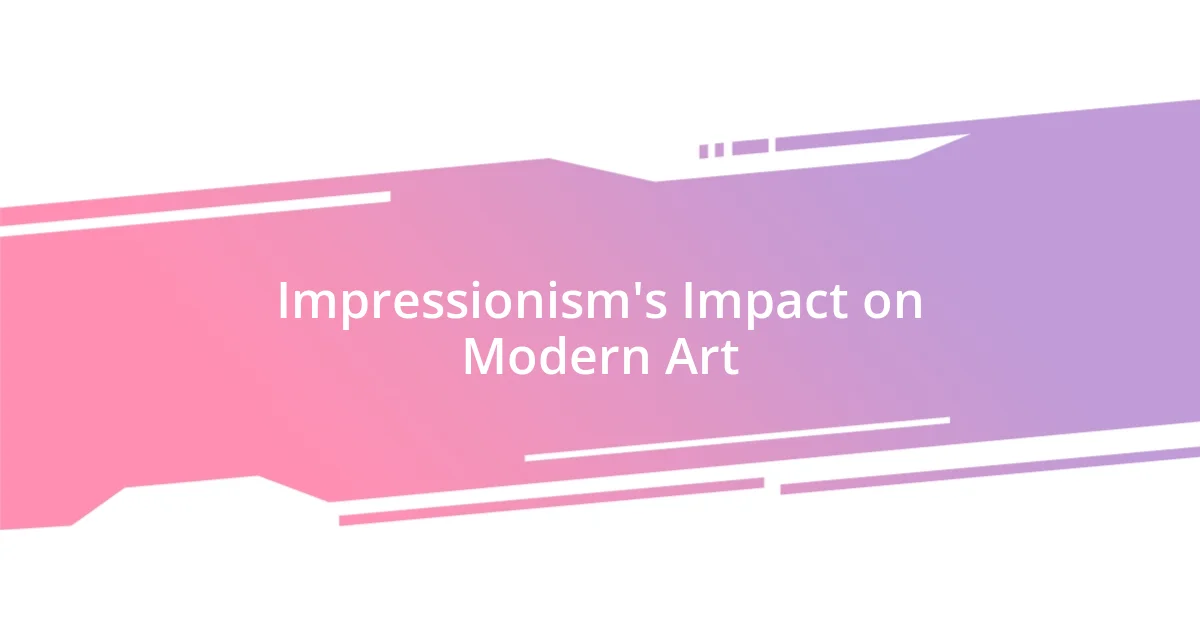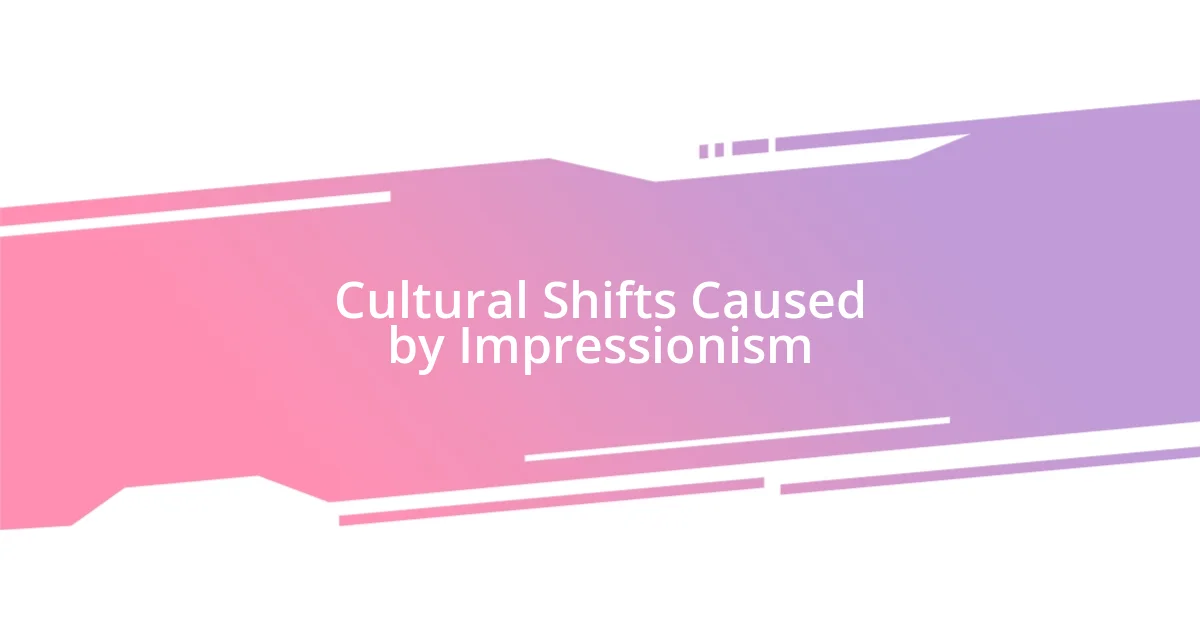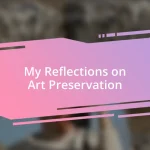Key takeaways:
- Impressionism revolutionized art by emphasizing personal perception and emotional experiences over traditional representation, influencing numerous modern art movements.
- Key Impressionist artists like Monet, Degas, and Renoir showcased unique perspectives, focusing on light, movement, and social connections in their works.
- The movement fostered a cultural shift towards appreciating everyday life and ordinary moments, encouraging a sense of community among artists and audiences through shared expression.

Overview of Impressionism’s Influence
Impressionism fundamentally transformed the art world, prioritizing personal experience and perception over traditional representation. This shift sparked a fierce discussion among artists and critics alike. I often wonder how shocking it must have been for audiences at the time to see color and light depicted with such freedom, rather than the meticulous detail they were accustomed to.
I remember standing in front of a Monet painting for the first time; the way the colors came alive on the canvas was genuinely mesmerizing. It wasn’t just a depiction of a natural scene but a feeling, an evocation of the moment. This emotional pull is precisely what Impressionism introduced to the art world—capturing fleeting moments and inviting viewers to experience the ephemeral nature of life.
Furthermore, the impact of Impressionism stretches far beyond its own movement, influencing modern art styles like Abstract Expressionism. The focus on subjective interpretation resonates in today’s contemporary art, encouraging us to appreciate the beauty and imperfection of our world. I often think about how vital this was; without Impressionism, would we even have the same appreciation for diversity in artistic expression?

Key Artists in Impressionism
When I think about the key figures in Impressionism, Claude Monet immediately comes to mind. His ability to capture light and color in a way that reflects the emotion of a moment is something that continues to resonate with me. One of my favorite experiences was seeing his “Water Lilies” series in person; the way he layers paint to create a shimmering effect felt almost magical. Monet’s relentless pursuit of capturing the fleeting beauty of nature truly defined the essence of Impressionism.
Then, of course, there’s Edgar Degas, who introduced a different perspective with his focus on movement, especially in his ballet scenes. I remember a visit to an art museum where I first encountered his work; the way he portrayed dancers in mid-pose felt so alive, as if I could almost hear the music. This dynamic approach to composition allowed viewers to see everyday moments with fresh eyes, creating a sense of intimacy between the subject and the observer.
Lastly, I can’t overlook Pierre-Auguste Renoir. His vibrant depictions of social scenes often celebrate joy and connection. I vividly recall the warmth I felt when viewing “Luncheon of the Boating Party”; the faces seemed to beam with happiness as they shared a moment together. Renoir’s art has a way of inviting us into the scene, making us feel as if we, too, are part of that joyful gathering. It’s fascinating to realize how these artists, each with their unique perspectives, contributed to the rich tapestry of Impressionism.
| Artist | Notable Work |
|---|---|
| Claude Monet | Water Lilies |
| Edgar Degas | ballet scenes |
| Pierre-Auguste Renoir | Luncheon of the Boating Party |

Techniques that Shaped Impressionism
In exploring the techniques that shaped Impressionism, I can’t help but think about the revolutionary use of color and light. Artists like Monet famously painted en plein air, or outdoors, allowing them to capture the changing qualities of light and atmosphere. I remember being outside on a sunny day, surrounded by blooming flowers, and feeling how the light shifts everything. Monet’s ability to replicate that experience on canvas feels like an invitation to slow down and truly observe our surroundings.
Additionally, brush strokes and composition played vital roles in defining this movement. Impressionists often employed short, thick strokes that allowed the viewer to almost see the process of creation. This method invites a sense of immediacy into the artwork. Here are some key techniques that contributed to the style of Impressionism:
- En plein air painting: Capturing light and color in natural settings.
- Loose brushwork: Creating a sense of movement and spontaneity.
- Color theory: Using complementary colors to enhance visual vibrancy.
- Focus on everyday scenes: Elevating ordinary subjects into art.
- Experimentation with composition: Employing unusual angles and viewpoints.
These techniques not only showcase the artists’ innovative approach but also inspire viewers like me to appreciate the beauty in movement and light around us.

Impressionism’s Impact on Modern Art
Impressionism has profoundly shaped the landscape of modern art, serving as a catalyst for future movements like Post-Impressionism and even Abstract Expressionism. I often find myself pondering how this focus on personal perception over realism allowed artists to explore emotions and concepts beyond what the eye can see. When I first encountered works influenced by Impressionism, such as Van Gogh’s expressive brushwork, I was struck by how these artists broke free from traditional constraints, inviting viewers to experience their inner worlds.
One fascinating aspect of Impressionism’s legacy is the emphasis on experimentation with new techniques, which encouraged artists to prioritize individual expression. I recall attending an art workshop where we were encouraged to paint with bold colors and loose brushstrokes. It was liberating! This immersive experience made me understand how Impressionism’s playful approach to color and form empowers artists to convey feelings and moods. I think about how this ethos resonates in contemporary art, where personal narratives take center stage.
Furthermore, the celebration of everyday life seen in Impressionism has opened up a new realm for modern artists to explore mundane subjects through a fresh lens. I remember visiting a gallery showcasing contemporary artists who embraced this philosophy, transforming ordinary scenes into extraordinary pieces of art. It made me realize how Impressionism’s influence stretches beyond technique; it has inspired a deeper appreciation for the beauty in our daily lives, prompting us to look again at what we often overlook.

Cultural Shifts Caused by Impressionism
The cultural shifts sparked by Impressionism are fascinating and profound. One key change was the movement away from strict artistic traditions. I often think about my first visit to an art museum, where I stood in front of Monet’s “Water Lilies.” It struck me how different it felt to view this “imperfect” beauty, and I realized that Impressionism encouraged everyone to embrace their unique perspectives. This shift broadened the definition of art, allowing a diverse range of expressions to emerge.
Additionally, Impressionism’s focus on the everyday transformed how society viewed life’s routine moments. For instance, when I look at paintings depicting bustling Parisian streets, I can’t help but appreciate the artistry in ordinary scenes. It made me reflect on how we often overlook the beauty around us. I remember taking a stroll through my neighborhood, noticing the play of light on a passing car or the way the clouds cast moving shadows. This influence urges us to find inspiration in daily experiences, enriching our connections with the world.
Moreover, Impressionism fostered a newfound sense of community among artists and audiences. The way creatives began hosting outdoor exhibitions, openly sharing their work with the public, resonates with me. I recall attending a local art fair where artists freely interacted with viewers, exchanging thoughts and ideas. It was exhilarating! This sharing atmosphere nurtured not only artistic collaboration but also created a supportive space for diverse voices. This encouragement of dialogue and connection remains vital in art today, reflecting the lasting legacy of Impressionism in our culture.

Lasting Legacy of Impressionism
The influence of Impressionism reaches far beyond its own era, impacting how we perceive and create art today. I’ll never forget visiting an exhibition that showcased modern interpretations of Impressionist techniques. As I stood in front of a canvas that vibrated with color and movement, I realized how far we’ve come. Isn’t it remarkable that artists still draw inspiration from those bold choices made more than a century ago? This dialogue across time illustrates the enduring spirit of Impressionism, inviting us to continually redefine our artistic expressions.
Another profound legacy of Impressionism is the shift in perspective it encouraged regarding what constitutes a subject worthy of art. I remember feeling a deep connection when I viewed an artwork portraying a simple coffee cup. It struck me that this ordinary object was transformed into something rich with meaning, a testament to everyday beauty. Why is it that we often overlook simple moments? Impressionism teaches us to embrace the mundane, inviting us to find inspiration in our immediate surroundings and giving us permission to explore themes often deemed unworthy of artistic exploration.
Finally, Impressionism’s open embrace of light and color has significantly shaped how contemporary artists approach their work. I distinctly recall the sense of joy I felt while painting outdoors, inspired by a warm sunset. The way colors blended effortlessly ignited my creativity and emphasized how emotion can be captured through art. It’s fascinating to think about how this legacy encourages artists to push boundaries, capturing fleeting moments and evoking feelings that resonate with viewers on a deeper level. Doesn’t it amaze you how a simple brushstroke can convey complex emotions? That’s the magic of what Impressionism has left behind.

Conclusion on Impressionism’s Relevance
Impressionism continues to be relevant today, encouraging us to embrace our individuality in artistic expression. I recall a recent chat with a friend who is an aspiring painter; she confessed that the loose brushwork in Impressionist pieces inspires her to experiment with her style. It struck me then how powerful that legacy is—challenging artists to break away from rigid conventions and explore their unique voices.
The movement also ignites a fresh perspective on everyday moments. One day, while sipping coffee in a bustling café, I paused to truly see the multi-hued reflections on my cup. I realized how Impressionists capture fleeting moments that often go unnoticed. Why do we tend to overlook such beauty in our daily lives? This invitation from Impressionism to savor the ordinary enriches our connection to the world and shapes how we find inspiration in our surroundings.
Above all, the camaraderie cultivated through Impressionism is still alive. I recently attended a community art workshop where artists of all backgrounds came together to share their experiences. The energy was palpable—artists exchanging ideas and expressing themselves freely reminded me of those outdoor exhibitions from the past. Isn’t it beautiful how that spirit of collaboration, nurtured by Impressionism, continues to foster creativity in a modern context? This ongoing dialogue between artists and audiences underscores the lasting impact of Impressionism, enriching our cultural landscape even today.














